For the 2025 school year, there is 1 public high school serving 46 students in Lincoln K-12 Schools School District. This district's average high testing ranking is 10/10, which is in the top 1% of public high schools in Montana.
Public High School in Lincoln K-12 School School District have an average math proficiency score of 50% (versus the Montana public high school average of 27%), and reading proficiency score of 50% (versus the 43% statewide average).
Public High School in Lincoln K-12 School School District have a Graduation Rate of 50%, which is less than the Montana average of 83%.
The school with highest graduation rate is Lincoln High School, with ≥50% graduation rate. Read more about public school graduation rate statistics in Montana or national school graduation rate statistics.
Minority enrollment is 11% of the student body (majority Hispanic and American Indian), which is less than the Montana public high school average of 23% (majority American Indian).
Overview
This School District
This State (MT)
# Schools
3 Schools
176 Schools
# Students
149 Students
45,513 Students
# Teachers
16 Teachers
3,275 Teachers
Student : Teacher Ratio
9:1
9:1
District Rank
Lincoln K-12 Schools School District, which is ranked within the top 50% of all 347 school districts in Montana (based off of combined math and reading proficiency testing data) for the 2021-2022 school year.
The school district's graduation rate of 50% has stayed relatively flat over five school years.
Overall District Rank
#149 out of 350 school districts
(Top 50%)
(Top 50%)
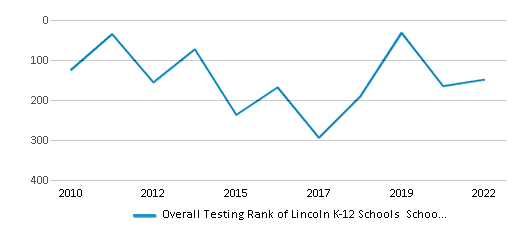
Math Test Scores (% Proficient)
35-39%
35%
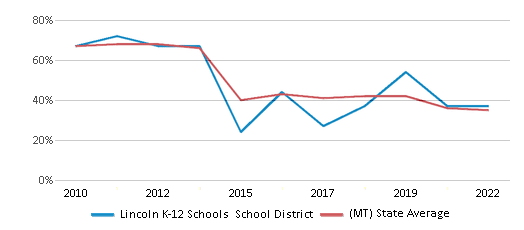
Reading/Language Arts Test Scores (% Proficient)
45-49%
46%
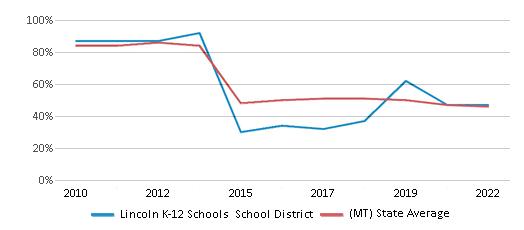
Science Test Scores (% Proficient)
21-39%
37%
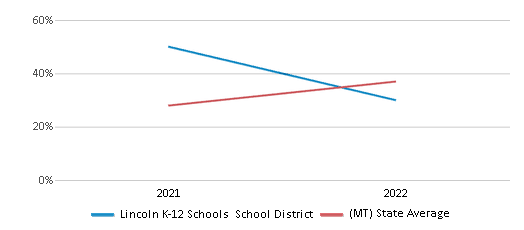
Graduation Rate
≥50%
86%
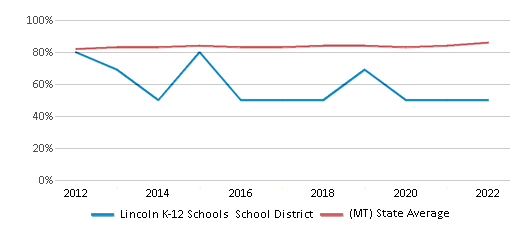
Students by Ethnicity:
Diversity Score
0.23
0.39
# American Indian Students
1 Student
4,790 Students
% American Indian Students
1%
10%
# Asian Students
n/a
353 Students
% Asian Students
n/a
1%
# Hispanic Students
11 Students
2,637 Students
% Hispanic Students
7%
6%
# Black Students
n/a
313 Students
% Black Students
n/a
1%
# White Students
130 Students
35,223 Students
% White Students
87%
77%
# Hawaiian Students
n/a
103 Students
% Hawaiian Students
n/a
n/a
# Two or more races Students
7 Students
2,092 Students
% of Two or more races Students
5%
5%
Students by Grade:
# Students in PK Grade:
10
-
# Students in K Grade:
8
9
# Students in 1st Grade:
9
22
# Students in 2nd Grade:
13
14
# Students in 3rd Grade:
12
10
# Students in 4th Grade:
10
17
# Students in 5th Grade:
12
14
# Students in 6th Grade:
11
10
# Students in 7th Grade:
6
16
# Students in 8th Grade:
12
28
# Students in 9th Grade:
16
11,994
# Students in 10th Grade:
12
11,945
# Students in 11th Grade:
11
11,006
# Students in 12th Grade:
7
10,428
# Ungraded Students:
-
-
District Revenue and Spending
The revenue/student of $15,953 is higher than the state median of $15,263. The school district revenue/student has declined by 6% over four school years.
The school district's spending/student of $15,960 is higher than the state median of $15,352. The school district spending/student has declined by 6% over four school years.
Total Revenue
$2 MM
$2,285 MM
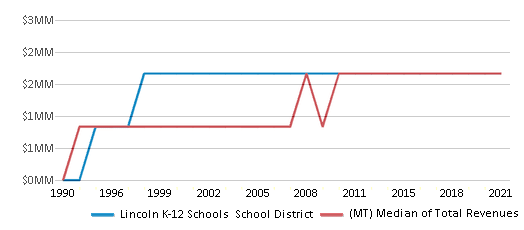
Spending
$2 MM
$2,298 MM
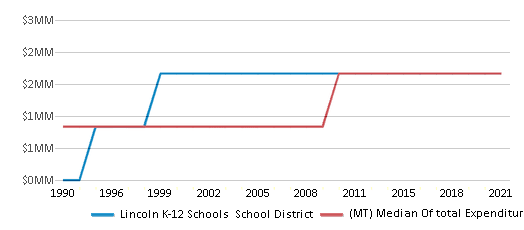
Revenue / Student
$15,953
$15,263
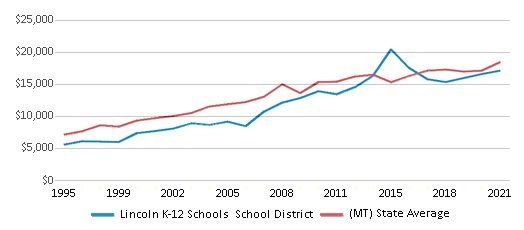
Spending / Student
$15,960
$15,352
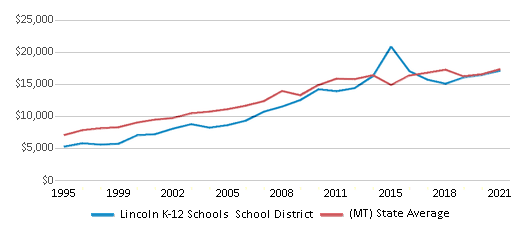
Best Lincoln K-12 Schools School District Public High Schools (2025)
School
(Math and Reading Proficiency)
(Math and Reading Proficiency)
Location
Grades
Students
Rank: #11.
Lincoln High School
(Math: <50% | Reading: <50%)
Rank:
Rank:
8/
Top 30%10
808 Main Street
Lincoln, MT 59639
(406) 362-4201
Lincoln, MT 59639
(406) 362-4201
Grades: 9-12
| 46 students
Recent Articles

Year-Round Or Traditional Schedule?
Which is more appropriate for your child? A year-round attendance schedule or traditional schedule? We look at the pros and cons.

Why You Should Encourage Your Child to Join a Sports Team
Participating in team sports has a great many benefits for children, there is no doubt. In this article you will learn what those benefits are.

White Students are Now the Minority in U.S. Public Schools
Increasing birth rates among immigrant families from Asia and Central and South America, combined with lower birth rates among white families, means that for the first time in history, public school students in the United States are majority-minority. This shift in demographics poses difficulties for schools as they work to accommodate children of varying language abilities and socio-economic backgrounds.





